
Fort Bowie in 1894 (above) and today. Click for a larger view
The second Fort Bowie operated from 1868 to 1894. Once the Apache wars were over in 1886, fort life became rather leisurely. Kerosene street lamps lit pathways between the buildings; a tennis court was in the officer's section; there were flushing toilets and even an ice machine; the men attended dances, played baseball and hunted.

Map of the fort. Click for a larger view

Aerial view of the ruins. Click for a larger view

The laundress quarters were located in an old mail station on the far fringes of the post, reflecting the social status of these women. Initially their quarters were at the abandoned first fort.
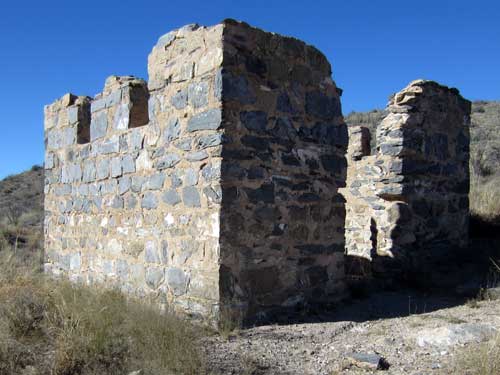
Also some distance from the main fort was the powder magazine, built in 1890... although for more reasonable reasons.
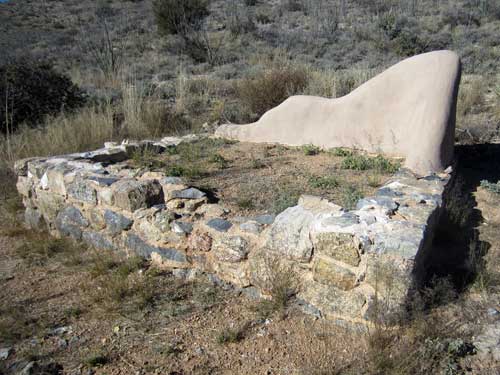
Artillery gun shed, 1890

View over the main fort

There wasn't much left of the Quartermaster Storehouse built in 1883. Most of the lumber was quickly salvaged by neighboring residents shortly after the fort closed.

Arrival for the mail in 1893. The quartermaster was responsible for supplies, construction and maintenance of buildings, contracts for firewood, and all forms of transportation. He also hired all civilian employees such as teamsters, carpenters, blacksmiths and masons.

Stables and corral, 1871 (with the ranger station in the background)

Civilian blacksmiths were preferred over extra-duty enlisted men since they were more competent and could work full-time, whereas a soldier had to alternate blacksmithing with his other duties. The saddler maintained all the leather equipment of the fort, from saddles and harnesses to packs and gun slings.

Informative signs helped us identify what we were looking at.

The cavalry mess hall. In the early days, good food was a constant problem. The soil was poor quality and other sources of fresh food were a day's ride or longer away. Cooks relied on canned food for taste variety and less risk of food poisoning.
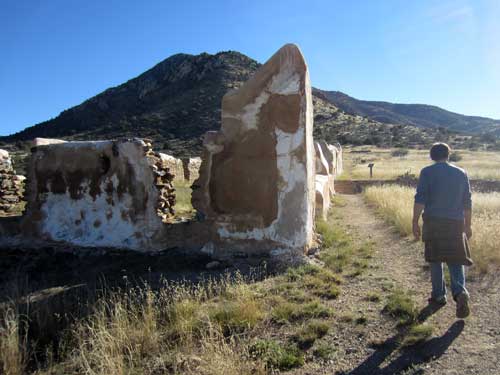
The cavalry barracks. This massive adobe structure was one of the first built.

There was no furniture inside other than single iron bunks, rifle racks and wood-burning stoves.
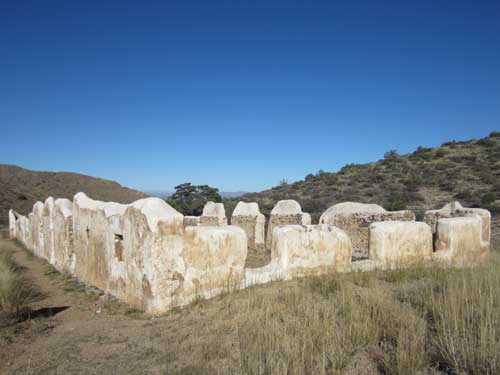

(Left to right) Cavalry barracks, tailor shop, officer's quarters, circa 1885. Note the street lamp

Geronimo in Fort Bowie in 1886. Click for a larger view

A dress parade

Commanding officer's quarters, circa 1885

The fort's most elaborate structure was a two-story Victorian-style mansion. Built in 1884-85, it cost about $4,000. In comparison, it only took $4,368 to build the entire fort in 1868-69. It had 13 rooms, including a drawing room, sewing room with a skylight, dining room and seven bedrooms. There were two verandas and two wings covered with fancy shingles in bands of alternating colors.

Inside

View from the far end of the fort

While we would have enjoyed exploring some more, the sun was getting low and we still had a mile and a half hike back to the car. We took the Overlook Ridge Trail back.

It was a rocky, steep climb but the views were worth it.

Overlooking the fort

The Post Trader or Sutler's Store, a civilian-owned store where the soldiers could buy provisions. The word Sutler comes from the Dutch 'zoetelaar' which originally meant 'one who does dirty work.'

Beginning our descent

Ocotillo is native to this area. For much of the year, it simply looks like a stand of large spiny dead sticks (although the stems are partly green). When it rains, the plant quickly becomes lush with small leaves. It even gets bright crimson flowers which are pollinated by hummingbirds and carpenter bees.

A view over Siphon Canyon, the way we came up

Ruth Shackelford, who passed through here with her family in 1868, wrote: Clear and warm. We were up before daybreak, got breakfast and started thru the Apache Pass, over awful roads, up hill and down. We had to tie the wagon wheels with ropes, and then in some places the men had to stand on the wheels to keep them from turning over. Every man who could leave the wagon had to take his turn and go on guard through the pass.... We got though by elven o'clock and were camped at the foot of the pass between the mountains, near a station where there is a company of soldiers. The Indians are very bad.

Looking down on the cemetery

I was concerned the the road would continue to get worse than it had been leading up to the fort and that we wouldn't make it over, but another couple who had just come from that way said it was mostly ok. And it was. After 8 miles of dirt road, we hit pavement again.
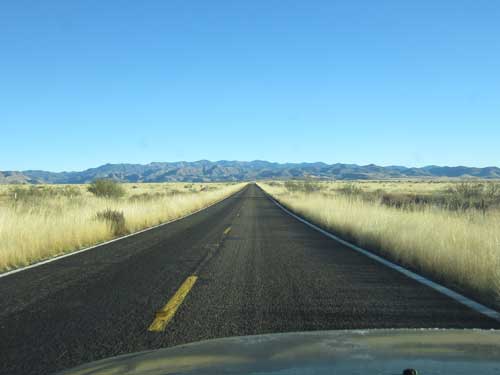


We arrived at Chiricahua National Monument about 15 minutes before the visitor center closed for the day. And since tomorrow was a holiday (Thanksgiving), it was going to be closed all day then too. But that worked to our advantage since we could pick any open camp spot without worrying about someone else booking it. The ranger (the husband of the woman we had spoken to at the Bowie ranger station) was quite helpful and friendly.
It wasn't too cold setting up tent but it was supposed to get down to almost freezing during the night. We made a fire in the grill and listened to the owls in the trees around us. It was indeed very cold... fortunately the new air mattress we had picked up in Silver City didn't leak!


